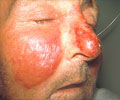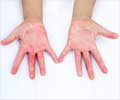It is an ordeal to imitate human diseases using an animal model but researchers have managed to come extremely close.

The response is so strikingly similar that it gives good reason for researchers to apply the strategy to a host of other infections to better understand how the immune system attempts to fights them— which could ultimately lead to precise treatment and prevention strategies.
"This is first time an interaction of an infectious agent with a host, the progression of the disease and its eventual resolution recapitulates what you would see in a human being," said Kishore R. Alugupalli, Ph.D., Assistant Professor of Microbiology and Immunology at Thomas Jefferson University and the Kimmel Cancer Center at Jefferson. "Our model is not only a susceptible model, but it actually tells us how the human immune system is functionally working. That is the big difference from the previous studies."
What really surprised the team is that the mouse physiological environment was able to facilitate the development of human B1-like cells, which is specialized type of antibody producing systems used to fight infection due to a variety of bacterial pathogens, including Pneumococcus and Salmonella.
In the study, researchers transferred hematopoietic stem cells from human umbilical cord blood into mice lacking their own immune system. This resulted in development of a human immune system in these mice. These "human immune system" (HIS) mice were then infected to gauge response.
According to the authors, an analysis of spleens and lymph nodes revealed that the mice developed a population of B1b-like cells that may have fought off the infection. Researchers also observed that reduction of those B cells resulted in recurrent episodes of bacteremia, the hallmark of relapsing fever.
Advertisement
"This would indicate that there is a functional equivalent of the subset in humans that has not been previously recognized," he added.
Advertisement
"It's an amazing platform that could be used to really study how the human B1 cells could work against a variety of bacterial and viral infections," said Dr. Alugupalli.
Source-Eurekalert















